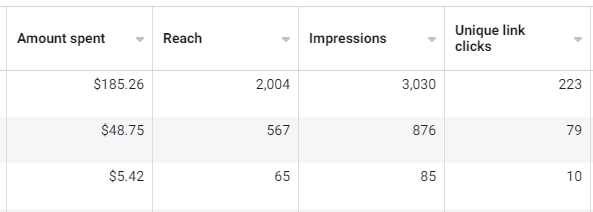Using Facebook Ad Rules
If you’ve ever wondered why some of your carefully crafted Facebook ads seem to rarely get shown, while others are capturing all the spotlight, you’re not alone. The ad giant’s algorithms are perplexing, and often leave authors both puzzled and frustrated as they struggle to promote their books. That’s why today, Ginger is diving into some of the reasons why not all of our ads are treated equally and what might be happening behind the scenes to cause this apparent imbalance.
Fortunately, he’s also giving us some ideas on how to level the playing field. One of the most powerful tools to make strategic adjustments to your ads is Facebook ad Rules, but very few authors are even aware that these Rules exist, much less what they’re used for. Yet by tweaking them, you can transform the way you manage your campaigns, giving you greater control over which ads are seen and more confidence that the best versions are being shown to your audience.
I regularly help self-published authors set up Facebook advertising campaigns for their books, and many of them share the same frustrations with the platform. One issue that keeps coming up is how Facebook’s algorithm won’t show all of an author’s ads equally.
You might have experienced this yourself. If you’ve ever run a Facebook campaign with multiple ads, you’ve probably observed that some of them will get more Impressions and Reach than others, even though they were all launched at the same time and share the same budget. This can be especially frustrating if the ads that aren’t getting all that attention are the ones with the lowest Cost-Per-Clicks.

So why does Facebook do this? And how can you ensure a fairer playing field for your book promotions?
Why Facebook Plays Favorites
In theory, Facebook’s ad delivery system is supposed to prioritize efficiency – showing the ads it predicts will perform best more frequently than the others.
However, this can be frustrating if you’re running a campaign with multiple creative variations, because you want each ad to have a fair shot at reaching your target audience.
It doesn’t solve the problem, but it might at least help to understand the methodology behind why Facebook chooses some ads over others (even if you’re not quite convinced that this methodology really works.)
At the heart of all this is an auction system that Facebook uses to decide which ads to show in the limited ad space available. Every time a Facebook user scrolls through their feed, they’ll pass various “placements” that Facebook reserves for showing ads. To decide which one to show, an ad auction takes place. Advertisers compete for that space, with Facebook awarding it to the ad that offers the highest combination of two factors – Bid and Relevance.
Here’s a breakdown of the key factors:
- Your Bid: This is the maximum amount you’re willing to pay for a click. Most of us just set a daily limit and don’t worry about setting a maximum Bid, but the option exists if you want to take it.
- Estimated Action Rates: Facebook predicts the likelihood of users taking your desired action (clicking through to your Amazon book page, for example).
- Relevance Score: Facebook scores your ad based on how well it aligns with the target audience’s interests and past behaviors.
Imagine two of your ads in this auction. Ad A has a catchy image and compelling copy that Facebook users respond to, resulting in a higher Relevance score. Ad B, however, lacks that punch. Even if you set the same bid for both, Ad A will likely win the auction because of its higher Relevance. This explains why some ads receive more impressions, even though they share the same budget. These ads are simply seen as more likely to be successful by Facebook’s algorithm.
But can we trust Facebook’s algorithm?
Behind the scenes, Facebook has an incredible wealth of information and data to use when making decisions for its advertisers and users. They are able to know things about the people you’re advertising to that they might not even know themselves!
So, in general, it’s fairly safe to trust Facebook’s decision about which ads to show more frequently. While it might be unsettling to see some of your ads get all the love, and others get completely ignored, this system should provide authors with the following:
- Priority Performance: Facebook prioritizes ads with a higher likelihood of driving clicks and conversions (sales). This means your most effective ads, or at least the ones that Facebook thinks will resonate best with your target audience, get the most exposure.
- Optimized Spend: In theory, the ads that Facebook shows most frequently should also perform the best, with lower Cost-Per-Clicks and Conversions (if you measure those.) By favoring higher-performing ads, Facebook helps you stretch your advertising budget further by not wasting money on ads that aren’t converting clicks into sales.
That’s the theory, anyway – but there’s a fine line between optimization and neglect. If one ad in your campaign completely dominates, the others might never get a chance to prove their worth. Facebook might tell you that the ads they show are more likely to be successful, but that’s difficult to prove unless all the ads get some visibility.
You could just take Facebook’s word for it, or you could manually tweak the system to balance things out. This is where Facebook’s built-in tools come in handy.
How can you make sure all your ads get displayed equally?
Facebook Ads Manager offers a feature called “Rules” that empowers you to take control of how your ads are delivered. Here’s how to use it to ensure a fairer chance for all your ads:
- Setting Up Campaign Budget Optimization: When creating your ad campaign, choose “Campaign Budget Optimization” under the “Budget & Schedule” section. This tells Facebook to distribute your total budget across all your ad sets (groups of ads within the campaign) to maximize your overall objective (likely “Traffic” in this case).
- Utilizing the Power of Rules: Once your campaign is running, navigate to the “Rules” section within Ads Manager. Click “Create Rule” and choose “Delivery.”
Here’s where you set the parameters for fair delivery.
- Metric: Choose “Impressions.”
- Comparison: Select “Is Less Than”
- Value: Enter a percentage of the average impressions your ad set has received. For example, if your average is 1,000 impressions and you want all ads to get at least 70% of that, enter “700” as the value.
Taking Action:
- Action: Here, you tell Facebook what to do when an ad falls below the threshold. Choose “Adjust Budget” and then “Increase By”
- Increase By: Set a percentage by which you want Facebook to increase the budget for underperforming ads. Start with a conservative number like 5% and monitor the results.
Essentially, this rule tells Facebook to monitor the impression share of each ad within your campaign. If an ad falls below the set threshold, Facebook will automatically allocate a slightly higher budget to it, giving it a chance to compete for more impressions.
- WARNING! When you start trying to meddle with Facebook’s algorithm, sometimes it meddles back! If you experiment with Rules, it’s crucial to monitor your campaign closely because you don’t want to overspend or have Facebook endlessly increase budgets for ads that simply aren’t performing well. Regularly review the Rule and adjust the parameters as needed based on your campaign data. The goal should be optimizing, not overriding Facebook’s system.
While a bit of nudging through Facebook’s ad Rules can be beneficial, also remember that the core auction system has its advantages. The goal of settling Rules shouldn’t necessarily be to force equal impressions for all your ads. Instead, you just want to ensure every ad has a fair chance to compete based on its relevance.
But which ads have the most relevance?
One of the reasons many self-published authors find Facebook’s behavior frustrating is because the whole reason they want all their ads to get equal impressions is so that they can test how well they do against each other.
It’s all very well for Facebook to prioritize one ad over the other, but if the neglected ad only has a handful of impressions, it doesn’t seem like Facebook even gave it a chance to succeed (or fail) and there’s no way to truly know how well Facebook users will respond to it.
Well, just as you can use Facebook ad Rules to force all your ads to be displayed equally, you can also use Rules as a powerful tool to identify the creative that resonates most strongly with your target audience.
A/B Testing with Facebook Ad Rules
Imagine having multiple ad variations, each featuring a different image or headline, all competing for the same audience. Facebook ad Rules allows you to set up a “fair fight” between these variations. Here’s how:
- Create Variations: Create a Traffic advertising campaign, and within it, design several ads with identical targeting but different creative elements. For example, you could have three ads with the same copy but different visuals. Just remember to only change one element at a time, otherwise it’s not really a fair test.
- Set Up the Rule: Here’s the magic. Within Facebook Ads Manager, create a Rule that automatically pauses any ad reaching 500 impressions. This ensures each variation receives a roughly equal number of views and then shuts off. This is also a great way to manage the amount of money you’ll spend on this experiment.
- Analyze and Optimize: Once the rule has paused all variations, analyze the results. Key metrics to consider include Click-Through Rate (CTR), Cost-Per-Click (CPC), and engagement (likes, comments, shares). The ad set with the highest CTR and lowest CPC indicates the most successful creative combination.
- Choose your ads: Although this method can determine a clear winner, it’s best to have a variety of ads in a campaign. I normally include any ad that has a CRT of 4% or more, and a CPC of $0.25 or less. I’ve worked out that these are the figures I need to hit in order to ensure that my advertising is profitable.
With this short campaign, you’re essentially conducting an A/B test – a scientific way to determine which ads resonate best with your audience. This data-driven approach eliminates guesswork and prevents you from wasting money on ads that don’t perform.
Other Metrics to Consider
While CTR and CPC are crucial to deciding which ads to run, you might want to also consider reviewing the Relevance Score for each ad: This score indicates how well your ad aligns with your target audience’s interests. A high score signifies a well-targeted ad that’s likely to perform better.
Also look at Engagement – by which I mean Likes and Comments. An ad that generates Likes and Comments makes your Facebook page more visible, and demonstrates that your ads are actually being noticed by people. Engagement offers you a deeper understanding of your audience’s preferences so you can tailor your future ads for even greater impact.
Knowledge is Power in Facebook Ads
Facebook has invested billions into providing the best and most efficient advertising platform that they can, so there’s a lot to be said for just trusting their instincts when running advertising campaigns – even if they do inexplicable things like favor one ad other another.
But Facebook are also aware of the limitations of their algorithm, and that’s why tools like Rules exist – to give advertisers greater control of their campaigns.
So don’t sweat it too much if Facebook is showing favoritism towards one of your ads – but also don’t miss the opportunity to gain greater understanding of your audience by experimenting with Rules.
Testing and analyzing ad variations through Facebook Rules empower you to identify the creative elements that truly capture your audience’s attention. You’ll no longer be throwing money at untested ideas. Instead, you’ll be armed with data-driven insights to optimize your ad spend and ensure your book reaches the right readers.
Remember, small changes can make a big difference. Using Rules to reduce your Cost-Per-Click from $0.40 to $0.20 might not seem like a big shift at first glance – but it’s basically doubling the effectiveness of your campaigns, and stretching your budget twice as far.
So, the next time you design a Facebook ad campaign, think about running some tests to dial in your creative. It can be one of the best ways to tighten your margins and make your advertising profitable.








